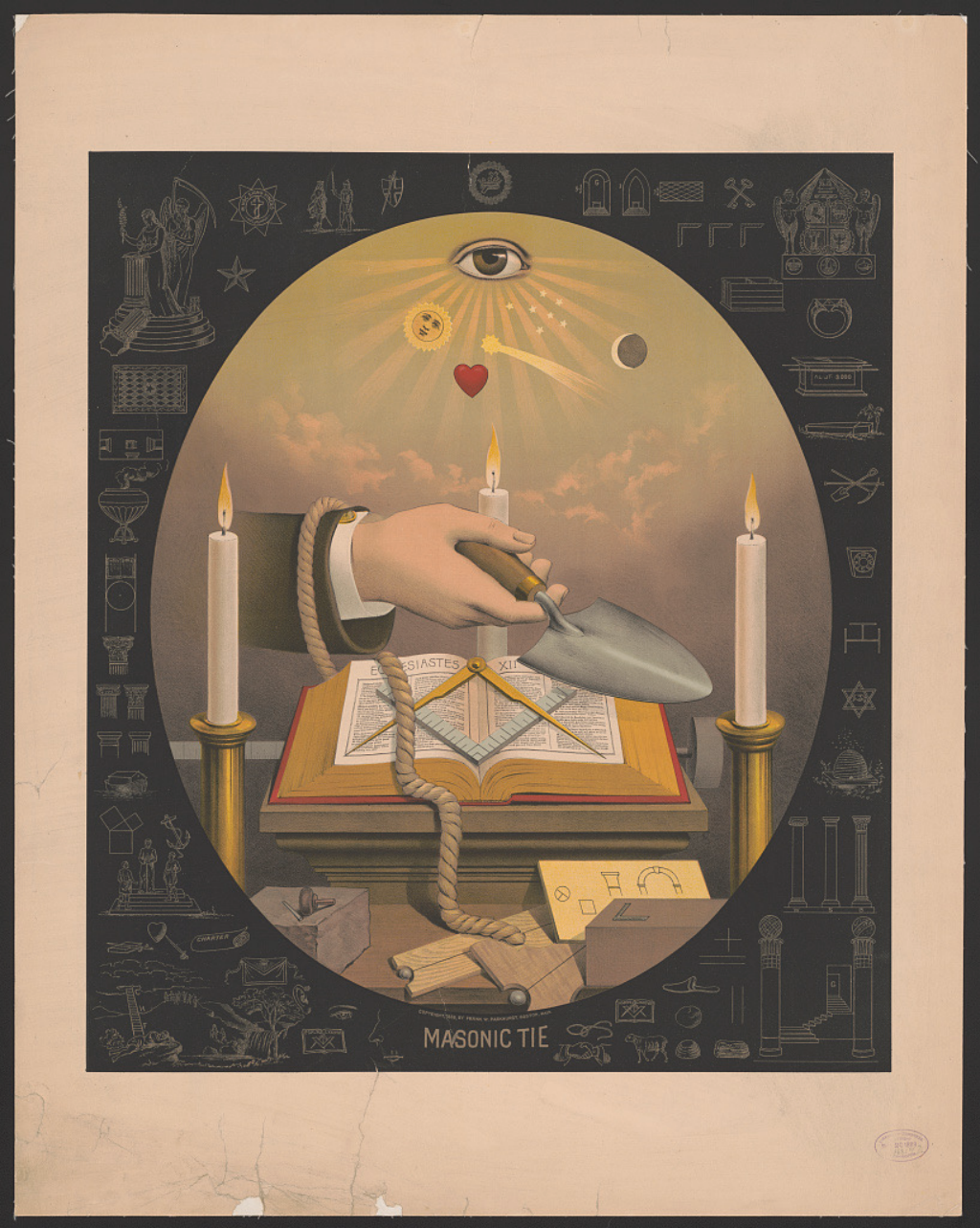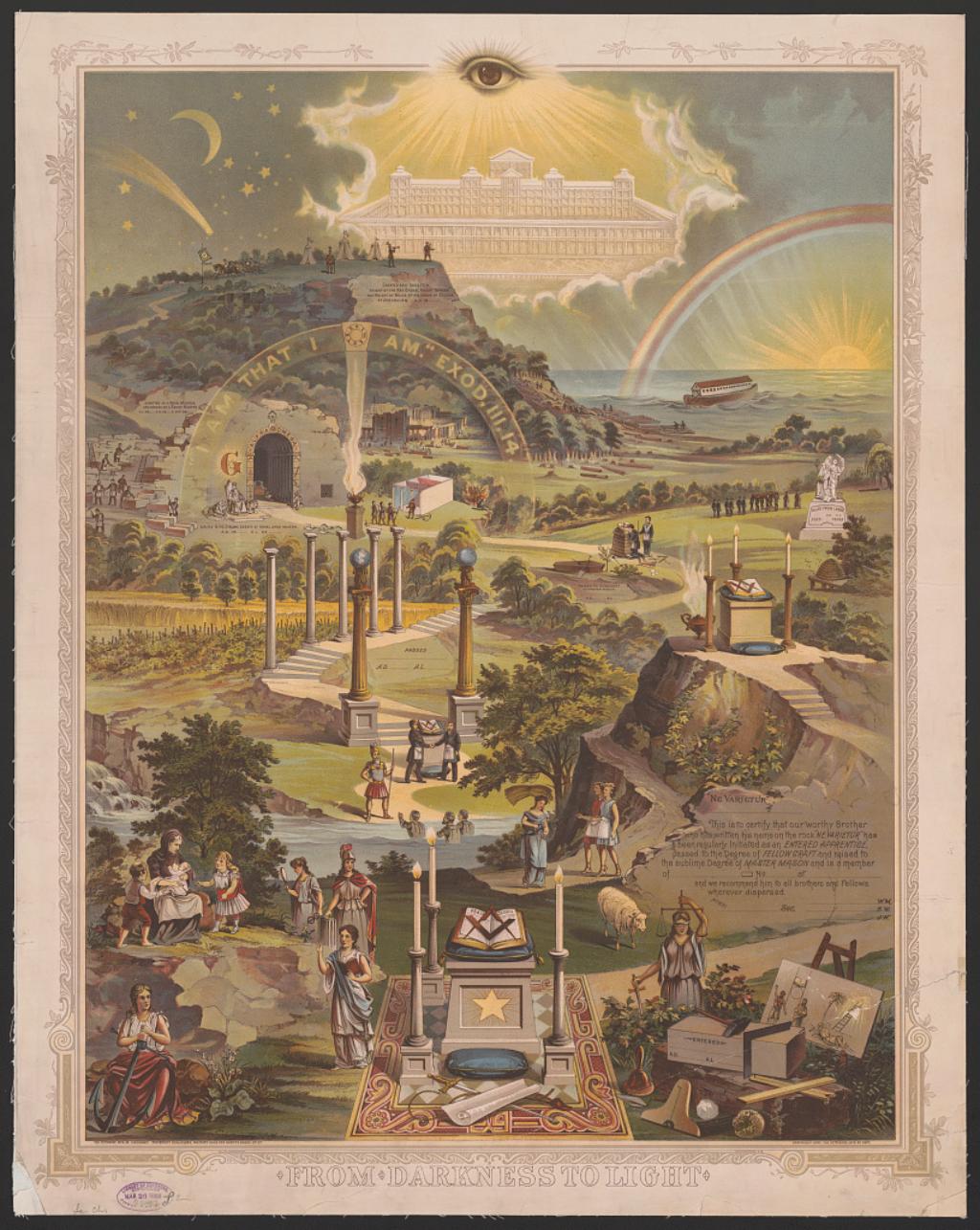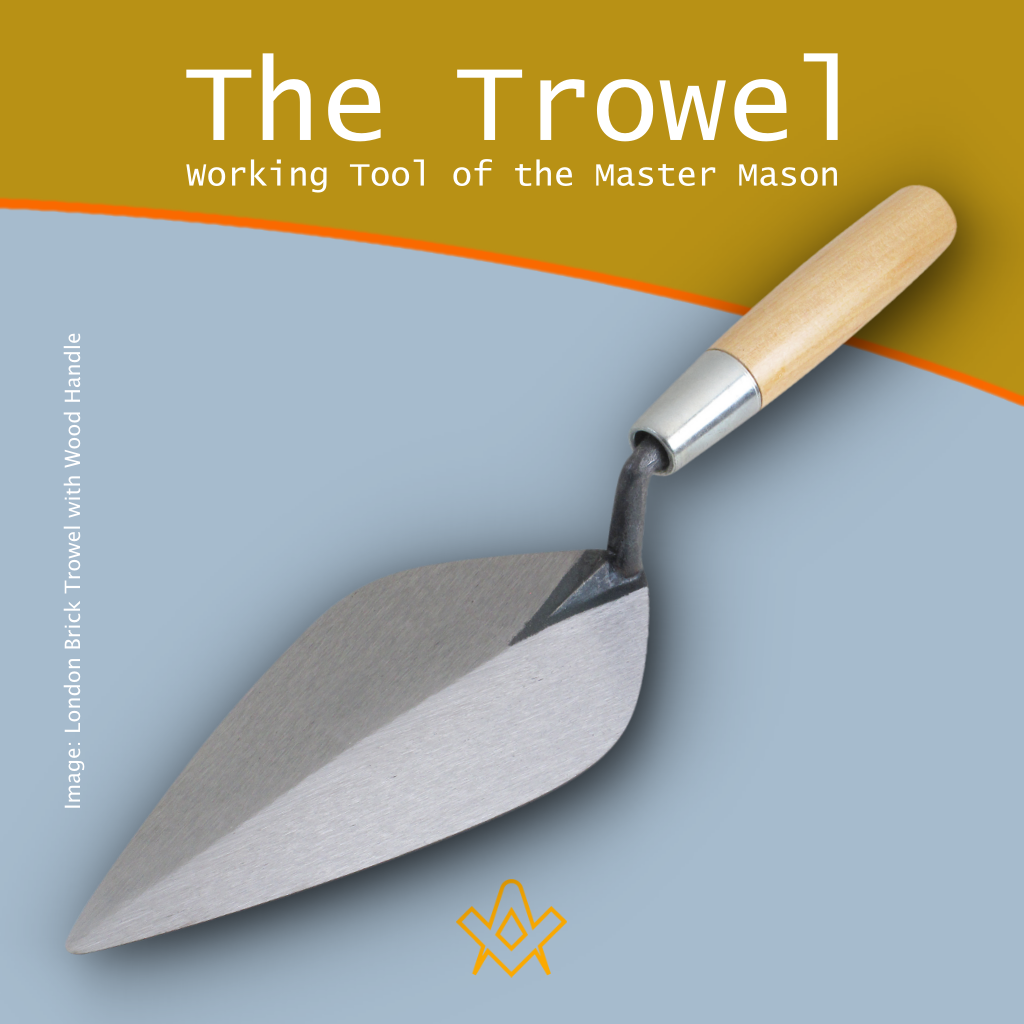
The working-tools of a Master Mason are all the implements of Masonry appertaining to the first three Degrees indiscriminately, but more especially the trowel.
The trowel is an instrument made use of by operative masons to spread the cement which unites a building into one common mass; but we, as Free and Accepted Masons are taught to make use of it for the more noble and glorious purpose of spreading the cement of brotherly love and affection; that cement which unites us into one sacred band, or society of friends and brothers, among whom no contention should ever exist, but that noble contention, or rather emulation, of who best can work and best agree.
Source: “The Working Tools of a Master Mason”, Duncan’s Masonic Ritual and Monitor (1866)
An implement of Operative Masonry, which has been adopted by Speculative Freemasons as the peculiar working-tool of the Master’s Degree. By this implement, and its use in Operative Masonry to spread the cement which binds all the parts of the building into one common mass, we are taught to spread the cement of affection and kindness, which unites all the members of the Masonic family, wheresoever dispersed over the globe, into one companionship of Brotherly Love and an old custom in an Oxford Lodge, England, gave it prominence as a jewel, and as a symbol it goes back to the practice of the Ancient.
Today this implement is considered the appropriate working-tool of a Master Mason, because, in Operative Masonry, while the Apprentice is engaged in preparing the rude materials, which require only the Gage and Gavel to give them their proper shape.
The Fellow Craft places them in their proper position by means of the Plumb, Level, and Square; but the Master Mason alone, having examined their correctness and proved them true and trusty, secures them permanently in their place by spreading, with the trowel, the cement that irrevocably binds them together.
The Trowel has also been adopted as the jewel of the Select Master. But its uses in this Degree are not symbolical. They are simply connected with the historical legend of the Degree.
Source: Mackey’s Encyclopedia of Freemasonry
THE TROWEL
Extracted from Symbolical Masonry (Harry L. Haywood, 1923) [1]

Masonic Tie. , 1889. [Boston: Publisher Not Transcribed] [Photograph] Retrieved from the Library of Congress,
IMAGE LINKED: Library of Congress Attribution 4.0 International (CC BY 4.0)
This emblem is like a key; while insignificant in itself, it opens up matters of such vast importance that to pursue its teachings through all their ramifications would itself require a book; consequently I can only hope to set down a few hints of the rich and various applications of it.
There is no need to say that of all working tools it is the most appropriate to the Master Mason Degree; it carries that significance upon its surface.
The Entered Apprentice, who can make only a beginning at the task of shaping the ashlar, needs only the gavel and the gauge.
The Fellow Craft, to bring the stone into completeness of size and form, requires the plumb, square, and level.
The Master Mason’s task is to set the finished stone in its place and bind it there, for which purpose the trowel is his most necessary tool.
Therefore the Master Mason has been given the Trowel as his working tool because it is most symbolic of his function in the great work of Temple Building.
When the Trowel has done its work there is nothing more to do, because the structure stands complete, a united mass, incapable of falling apart.
The stones which were many have now, because of the binding power of the cement, become as one.
If the stone represents an individual man, and if the Temple represents the Fraternity as a whole, it is evident that the Trowel is the symbol of that which has power to bind men together.
Therefore arises the question, “What is this unifying power?” Let us undertake to answer this question from several points of view; the individual, the Fraternity, and the world at large.
We very frequently meet with men who seem to lack unity in their makeup; a spirit of disorganization is at work in them so that they seem to live at cross-purposes with themselves.
What they know they should do they do not, and many things which they do they do against their own will.
They may have personal force, but it is scattered and their lives never come to a focus. These men we say that they lack character and we say right.
Character comes from a word that meant originally a graving tool; after long use the name of the tool came to be applied to the engraving itself, and thus the term has come to stand for a man whose actions give one an impression of definiteness and clear-cuttedness, like an engraving.
A man who lacks character is a blur, a confused and self-contradictory mass of impulses and forces. The one salvation for such a man is to find some means of unifying himself, of using himself to some purpose so as to arrive at some goal.
What can he use? We may answer, perhaps, that he can best use an ideal, for an ideal is nothing other than a picture of what one wills to be which he ever keeps before him, as an architect refers to his blue prints.
In short, the man needs a plan to live by, a thing we have symbolized in our Ritual by means of the tracing board.
Before the time of the Reformation, builders did not use plans drawn to scale as architects now do, but laid out their building design on the ground, or even on the floor of the workshop or the lodge.
In early English lodges this design was often drawn on the floor in chalk by the Master, and the youngest Entered Apprentice would erase it with a mop and water at the end of the ceremony; after a while, to make this labor unnecessary.
“The plan of work” was drawn on a permanent board which was set on an easel and exhibited during the degree, as is still done in England.
The tracing board of a degree, therefore, is the plan of work for that degree, drawn in symbols and hieroglyphics.
The tracing board itself, as it stands in the lodge, is a constant reminder to the Mason that, as a spiritual builder, he must have a plan or an ideal for his life.
When the Mason does live in loyalty to an ideal he is a man of character, his faculties work in unison, there is no war between his purposes and his behavior, and he is able to stand among his brethren as a completed temple. Such a man has used a trowel in his own life.

From Darkness to Light. , 1888. [Cincinnati: Publisher Not Transcribed] Photograph. Retrieved from the Library of Congress,
IMAGE LINKED: Library of Congress Attribution 4.0 International (CC BY 4.0)
It is more difficult to answer the question;
“What is the force that can unite individual Masons into a unified and harmonious Order?”
A practicable answer may be found by asking a further question, “What is it that now unites us, even if imperfectly?” “What is the cement?”
Perhaps we cannot point to any one thing. When I inquire of my own heart what it is that ties me to my fellow Masons I find myself thinking of many things.
There is the sense of a wonderful history which links us to unknown brethren who lived generations ago.
There is the symbolism of the Society, in which precious truths and living philosophies have been poured as into golden vases.
There is the spirit which pervades the Order, a sense of oneness in purpose and aims, of tolerance, of charity, of patience and forbearing; there is also the remembrance of the obligation which I voluntarily assumed, and which wove into my heart a silken thread, the other end of which is woven into the hearts of my brethren.
These and similar influences hold me to the Craft now and ever shall, but how to sum them up in one word I know not, except that word be Brotherhood.
Brotherhood has suffered much from over-use, from sentimentalism and from oratory, but no other word can be found to take its place.
Therefore we may say that, so far as the Fraternity itself is concerned, the trowel and the cement spread on by the trowel, is the kindly, pervasive, irresistible spirit and power of Brotherhood.
True it is that:

“Fellowship is heaven;
The lack of fellowship is hell.”
If this be so we have already an answer to our last question;
“What power can unite the scattered peoples and nations of the earth, especially in a time like this when they are more than ever sundered by passion and hatred?”
Surely, if the spirit and influence of Brotherhood can call together two million men out of all classes and localities of America and can bind them into the solidarity of a great united Order.
That same power can accomplish similar results if applied to the world at large. Diplomats and politicians do not seem to believe it, but it is true nevertheless, trite as it may sound.
Freemasonry’s benign genius of Fraternity was never more badly needed in the earth than just now.
Every device has been used to bind the peoples together; force, money, fear, superstition, and what not.
Let us hope that sooner or later the race will try the means proved so effective by more than two hundred years of Freemasonry.
[1] Haywood, Harry L. Symbolical Masonry (New York, New York; George H. Doran, 1923) pgs, 264 – 267
Further Reading

Symbolic Masonry: An Interpretation of the Three Degrees
By: H. L. Haywood
Symbolical Masonry is a treasure-house of Masonic lore, including discussions of key concepts of the first three degrees, along with an extensive study guide.
Haywood goes into details about such mysteries as the Letter ‘G’, the two pillars, and the legend of Hiram Abiff.
Not merely a rote discussion of the rituals and regalia of the lodge, Haywood attempts to get the reader to think critically about the background of these topics, enhancing their understanding of the rich history of Freemasonry.

ENCYCLOPEDIA OF FREEMASONRY Vol 1
By: Mackey Collection
And its Kindred Sciences Comprising the Whole Range of Arts, Sciences and Literature as Connected With the Institution.
Mackey knew that very few men have the means, time, and the inclination for the purchase of numerous books, and for the close and attentive reading of them…to acquire a knowledge of all matters connected with the science, the philosophy, and the history of his Order.
It was this thought that suggested to him that he should collect materials for a work which under one cover might help to enlighten his Brethren.
This book is so absorbing you could sit and read it from cover to cover. It also serves as a handy reference guide for any Masonic question that may arise. Highly recommended.
Recent Articles: symbolism
 The Practice of Freemasonry - P1 Embark on a transformative journey with Freemasonry, where the exploration of your Center unlocks the Perfect Ashlar within. Through the practices of Brotherly Love, Relief, Truth, and Cardinal Virtues, discover a path of enlightenment and self-improvement. Embrace the universal creed that binds us in the pursuit of our true essence. |
 Discover the fascinating history and significance of the Warrant of Constitution within Freemasonry. Unveil the evolution of this crucial authorization, its role in legitimizing Lodges, and its lasting impact on the global brotherhood of Freemasons. Explore the intricate link it provides between tradition and modern practice. |
 Freemasonry: Unravelling the Complexity of an Influential Organization Mysterious and captivating, Freemasonry has piqued the interest of seekers and skeptics alike. With its intricate blend of politics, esotericism, science, and religion, this enigmatic organization has left an indelible mark on society. Prepare to delve into the secrets of Freemasonry and unlock its hidden depths. |
 Unlocking the Mysteries of Freemasonry: In the hallowed halls of Freemasonry, a powerful symbol lies at the heart of ancient rituals and teachings—the Volume of the Sacred Law. This sacred book not only guides the spiritual and moral journey of Freemasons but also serves as a beacon of universal wisdom and enlightenment. |
 The Ancient Liberal Arts in Freemasonry Embark on a journey of self-improvement and wisdom with Freemasonry's guiding principles. Ascend the winding stairs of moral cultivation, analytical reasoning, and philosophical understanding. Embrace arithmetic's mystical properties and geometry's universal truths. Let the harmony of the universe inspire unity and growth. Discover the profound, hidden knowledge in Freemasonry's path to enlightenment. |
 Initiation rituals around the world are filled with fascinating elements and different images. One of them is that of darkness. When societies speak of darkness, they often mean a lack of knowledge, a lack of choice, or a symbol of evil. During initiation rituals, darkness is used to represent the initiate's lack of knowledge about the world, society, and initiation in general. It can also represent the initiate's inability to make a choice or endure a situation. Whether you have participated in an initiation rite or not, the meaning of darkness remains an intriguing concept worth exploring. Initiation rituals around the world are filled with fascinating elements and different images. One of them is that of darkness. When societies speak of darkness, they often mean a lack of knowledge, a lack of choice, or a symbol of evil. During initiation rituals, darkness is used to represent the initiate's lack of knowledge about the world, society, and initiation in general. It can also represent the initiate's inability to make a choice or endure a situation. Whether you have participated in an initiation rite or not, the meaning of darkness remains an intriguing concept worth exploring. |
 Masonic Deacon rods potentially trace their origins to Greek antiquity, symbolically linked to Hermes' caduceus. As Hermes bridged gods and mortals with messages, so do Masonic Deacons within the lodge, reinforcing their roles through ancient emblems. This connection underscores a profound narrative, weaving the fabric of Masonic rites with the threads of mythological heritage, suggesting the rods are not mere tools but bearers of deeper, sacred meanings that resonate with the guardianship and communicative essence of their divine counterpart, Hermes, reflecting a timeless lineage from myth to Masonic tradition. |
 The biblical pillars erected by Solomon at the Temple's porch, hold a profound place in history. These brass behemoths are not mere decorations; they are symbols of strength, establishment, and divine guidance. Explore their fascinating construction, dimensions, and the deep meanings they carry in both biblical and Masonic contexts. |
 Unlocking the Mind's Potential: Dive deep into ground breaking research revealing how simple daily habits can supercharge cognitive abilities. Discover the untapped power within and redefine your limits. Join us on this enlightening journey and transform your world! |
 Dive deep into the symbolic importance of the trowel in Masonry, representing unity and brotherly love. From its historical roots in operative masonry to its significance in speculative masonry, this article explores the trowel's multifaceted role. Discover its connection to the sword, the story of Nehemiah, and the Society of the Trowel in Renaissance Florence. Unravel the layers of meaning behind this enduring Masonic symbol. |
 Symbolism of The Builder's Jewel Batty Langley's "The Builder’s Jewel" (1741) is a visual masterpiece of Masonic symbolism, showcasing Langley's deep understanding of Freemasonry. The frontispiece highlights key symbols like the three pillars and the legend of Hiram Abiff, emphasizing Langley's dedication to Masonic traditions and teachings. |
 Unveil the mystique of the colour blue in Masonic symbolism. A hue evoking universal friendship and benevolence, its roots span ancient cultures, infusing Freemasonry's core values. This article explores blue's profound significance, guiding Freemasons towards wisdom and spiritual enlightenment. Discover the fascinating journey of this universal symbol. |
 Discover the intriguing world of the plumb in Masonic symbolism with our in-depth analysis. Uncover its rich history, moral teachings, and significance in Freemasonry, guiding members on their path to truth, integrity, and justice. Immerse yourself in the captivating power of this symbol that shapes lives within the brotherhood. |
 Unlock the mysteries of Freemasonry with 'The Key,' a profound Masonic symbol. This seemingly simple instrument holds a deeper meaning, teaching virtues of silence and integrity. Explore its ancient roots, from Sophocles to the mysteries of Isis, and discover how it symbolizes the opening of the heart for judgment. |
 Unlock the secrets of the Freemasonry with The Blazing Star - a symbol that holds immense significance in their rituals and practices. Delve into its history, meaning and role in the different degrees of Freemasonry with expert insights from the Encyclopedia of Freemasonry by Albert Mackey. Discover the mystique of The Blazing Star today! |
 There is no symbol more significant in its meaning, more versatile in its application, or more pervasive throughout the entire Freemasonry system than the triangle. Therefore, an examination of it cannot fail to be interesting to a Masonic student. Extract from Encyclopedia of Freemasonry by Albert Mackey |
 The Hiramic Legend and the Myth of Osiris Hiram Abiff, the chief architect of Solomon’s Temple, is a figure of great importance to Craft Freemasonry, as its legend serves as the foundation of the Third Degree or that of a Master Mason. He is the central figure of an allegory that has the role of teaching the Initiate valuable alchemical lessons. Although his legend is anchored in biblical times, it may have much older roots. |
 This rite of investiture, or the placing upon the aspirant some garment, as an indication of his appropriate preparation for the ceremonies in which he was about to engage, prevailed in all the ancient initiations. Extract from The Symbolism of Freemasonry by Albert G. Mackey |
 The All-Seeing Eye of God, also known as the Eye of Providence, is a representation of the divine providence in which the eye of God watches over humanity. It frequently portrays an eye that is enclosed in a triangle and surrounded by rays of light or splendour. |
 What's in a Word, Sign or Token? Why do Freemasons use passwords, signs, and tokens? As Freemasons we know and understand the passwords, signs and tokens (including grips), which are all used a mode of recognition between members of the fraternity. |
 A Temple of Living Stones: Examining the Concept of a Chain of Union What are the origins of the Chain of Union? And how did they come about ? The answers may surprise some members as W Brother Andrew Hammer investigates, author of Observing the Craft: The Pursuit of Excellence in Masonic Labour and Observance. |
 One of the best loved stories for the festive season is ‘A Christmas Carol’. A traditional ghost story for retelling around the fire on a cold Christmas Eve, it is a timeless classic beloved by those from all walks of life. Philippa explores the masonic allegory connections… |
 The Trowel - Working Tool of the Master Mason The Trowel is the symbol of that which has power to bind men together – the cement is brotherhood and fellowship. |
 Two Perpendicular Parallel Lines The point within a circle embordered by two perpendicular parallel lines, with the Holy Bible resting on the circle, is one of the most recognizable symbols in Freemasonry. It is also one which always raises a question. How can two lines be both perpendicular and parallel? |
 "The first great duty, not only of every lodge, but of every Mason, is to see that the landmarks of the Order shall never be impaired." — Albert Mackey (1856) |
 It is common knowledge that the ancient wages of a Fellowcraft Mason consisted of corn, wine, and oil. |
 “Do not come any closer,” God said. “Take off your sandals, for the place where you are standing is holy ground.” Exodus 3:5 |
 The Secret Language of the Stone Masons We know of Masons' Marks but lesser known are the 'argots' used by the artisans - in part 2 of a series on the social history of the Operative Masons we learn how the use of secret languages added to the mystery of the Guilds. |
 The phrase appears in the Regius Poem. It is customary in contemporary English to end prayers with a hearty “Amen,” a word meaning “So be it.” It is a Latin word derived from the Hebrew word - Short Talk Bulletin - Vol. V June, 1927, No.6 |
 Egypt's 'Place of Truth' - The First Operative Stone Masons' Guild? Was ancient Egypt's 'village of the artisans' the first operative stone masons' guild? And was their use of 'identity marks' a forerunner of the Mason's Marks of the cathedral builders of the Middle Ages? Read on for some possible answers… |
 The Pieces of Architecture and the Origin of Masonic Study Discover the journey of the Apprentice – from Operative to Speculative. This journey has been carried out since the times of operative Freemasonry but today the initiate works in the construction of his inner temple. |
 The Builders' Rites - laying the foundations operatively and speculatively The cornerstone (also ‘foundation’ or ‘setting’ stone) is the first stone to be set in the construction of the foundations of a building; every other stone is set in reference to this. |
 Applying the working tools to achieve our peculiar system of morality. |
 We take an in-depth look at the 47th Proposition of the 1st Book of Euclid as part of the jewel of the Past Master. |
 The Cable Tow: Its Origins, Symbolism, & Significance for Freemasons - Unbinding the significance of the cable tow. |
 We examine at one of the most impressive moments of the initiatory ceremony, a certain rite known as Circumambulation, and ask what is its meaning and purpose ? |
 So, what is the Level? And why do we use it in Freemasonry? |
 What is the mysterious pigpen or Masonic cipher that has been used for centuries to hide secrets and rituals? |
 The Story of the Royal Arch - The Mark Degree Extracted from William Harvey's 'The Story of the Royal Arch' - Part 1 describes the Mark Degree, including the Working Tools. |
 Ashlars - Rough, Smooth - Story of a Stone How we can apply the rough and smooth Ashlars with-in a masonic context |
 A detailed look at the Chamber of Reflection: A Revitalized and Misunderstood Masonic Practice. |
 Exploring the origin and symbolism of Faith, Hope and Charity |
 The Noachite Legend and the Craft What is it to be a true Noachidae, and what is the Noachite Legend and the Craft ? |
 In Masonic rituals, Jacob’s ladder is understood as a stairway, a passage from this world to the Heavens. |
 What is the meaning of the Acacia and where did it originate ? |
 What is the connection with the Feasts of St John and Freemasonry |
 The Forget-Me-Not and the Poppy - two symbols to remind us to 'never forget' those who died during the two World Wars. |
 Biblical history surrounding the two pillars that stood at the entrance to King Solomon's Temple |
 Is there a direct link between Judaism and Freemasonry? |
 The symbolism of the beehive in Masonry and its association with omphalos stones and the sacred feminine. |
 The Wages of an Entered Apprentice |
 An explanation of the North East corner charge which explores beyond one meaning Charity - |
 A brief look at the origins of the two headed eagle, probably the most ornamental and most ostentatious feature of the Supreme Council 33rd Degree Ancient and Accepted (Scottish ) Rite |
 A Muslim is reminded of his universal duties just as a Freemason. A Masonic Interpretation of the Quran's First Two Chapters |
 The three Latin words -{Listen, Observe, Be Silent}. A good moto for the wise freemason |
masonic knowledge
to be a better citizen of the world
share the square with two brothers

click image to open email app on mobile device








